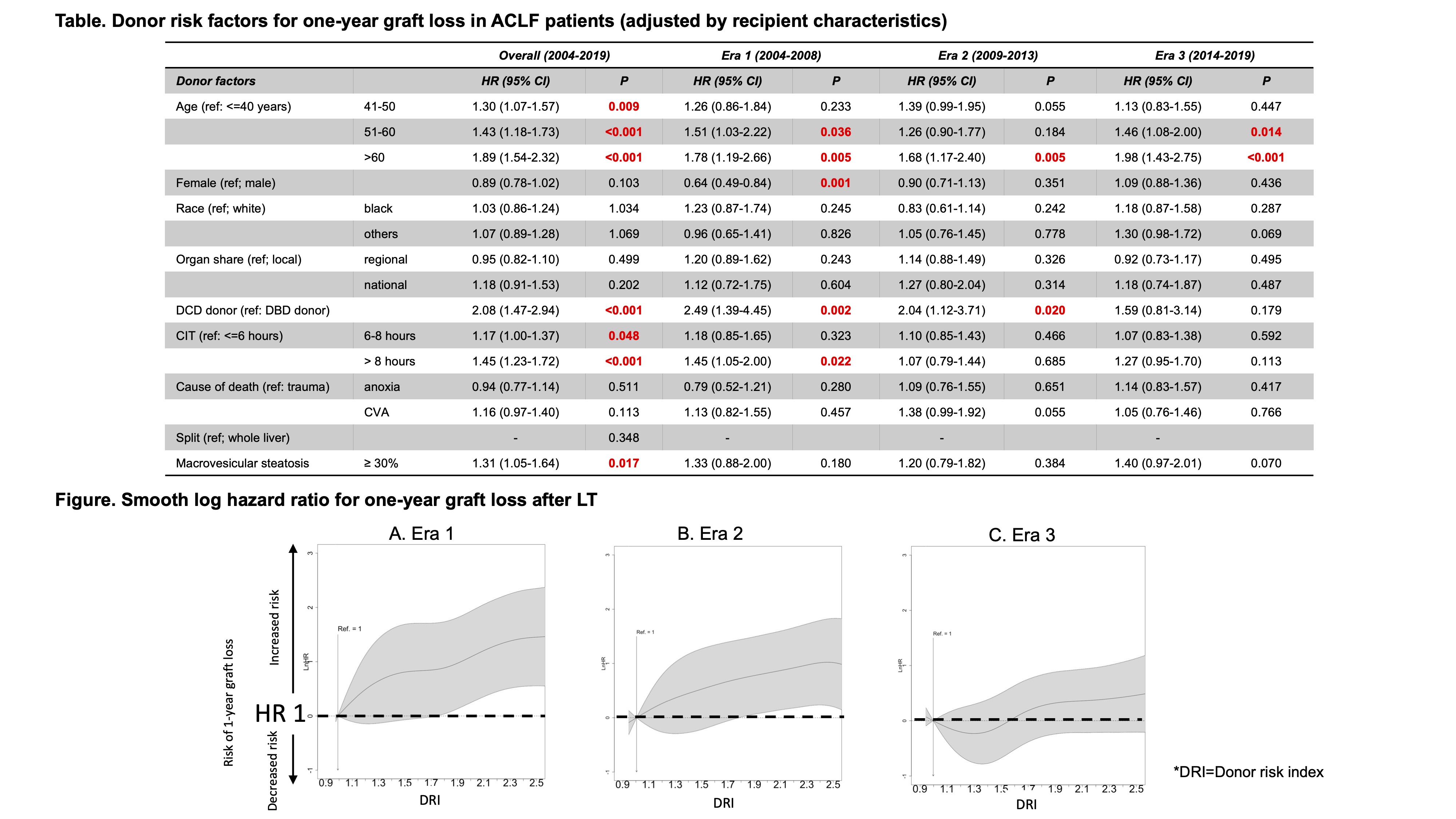Improved Outcomes Over Time of Extended Criteria Donor Grafts for Acute-on-chronic Liver Failure
Transplant and Hepatobiliary Surgery, Henry Ford Hospital, Detroit, MI
Meeting: 2021 American Transplant Congress
Abstract number: 181
Keywords: Donors, marginal, Liver failure, Liver transplantation
Topic: Clinical Science » Liver » Liver: MELD, Allocation and Donor Issues (DCD/ECD)
Session Information
Session Name: MELD, Allocation and Donor Issues
Session Type: Rapid Fire Oral Abstract
Date: Sunday, June 6, 2021
Session Time: 6:00pm-7:00pm
 Presentation Time: 6:00pm-6:05pm
Presentation Time: 6:00pm-6:05pm
Location: Virtual
*Purpose: Given the high waitlist mortality of patients with acute-on-chronic liver failure (ACLF), liver transplant (LT) with an extended criteria donor (ECD) can be considered. The use of ECD livers has been associated with increased post-transplant mortality in ACLF patients. However, the trends over time for LT with ECD have not been investigated. This study aims to analyze trends in post-transplant outcomes with ECD in ACLF and determine risks associated with specific ECD criteria.
*Methods: Using OPTN/UNOS data, we analyzed LT recipients with ACLF between 2004 and 2019. Patients with status 1A, multi-organ and re-transplant were excluded. ACLF was defined using EASL-CLIF criteria. In recipients with donor risk index (DRI)≥1.7, one-year graft survival (GS) was compared between 3 eras: Era1 (2004-08), Era2 (2009-13), and Era3 (2014-19). The cut-off of 1.7 is based on the definition of marginal grafts in the literature. Donor risk factors for one-year graft loss were analyzed in each era using Cox proportional hazard model, with adjustments for recipient variables. Finally, the impact of DRI as an independent continuous predictor of one-year graft loss was evaluated in each Era.
*Results: 30,080 eligible ACLF patients were identified, of whom 7,909 (26.3%), 9,511 (31.6%), and 12,660 (42.1%) were transplanted in Era1, Era2 and Era3. When comparing post-transplant outcomes in ACLF patients with DRI≥1.7, Era3 (85.1%) had significantly better 1-year GS than Era1 (75.4%, P<0.001) and Era2 (82.5%, P=0.007). On multivariable analysis, older donor (age 51-60, >60), DCD donor, and prolonged CIT (>8 hours) were independent risk factors for 1-year graft loss in Era1. In contrast, risk factors in Era2 included older donor age (age>60) and DCD, whereas in Era3 only older donor age (age 51-60, >60) was associated with 1-year graft loss (Table). On evaluation of DRI as a continuous predictor, a higher DRI was associated with an increased hazard of 1-year graft loss in Era1 and Era2. In contrast, a similar risk of graft loss was found across all DRI values in Era3 (Figure).
*Conclusions: In ACLF patients, outcomes using ECD livers improved over time. Only older donor age was significantly associated with worse post-transplant outcomes across all three eras. The use of DCD graft and prolonged CIT was associated with graft loss in the earlier but not late era. DRI is not an independent risk factor for graft loss in the most current era. These findings support the contemporary use of ECD livers in ACLF patients.
To cite this abstract in AMA style:
Kitajima T, Ivanics T, Moonka D, Shamaa T, Mohamed A, Delvecchio K, Collins K, Rizzari M, Yoshida A, Abouljoud M, Nagai S. Improved Outcomes Over Time of Extended Criteria Donor Grafts for Acute-on-chronic Liver Failure [abstract]. Am J Transplant. 2021; 21 (suppl 3). https://atcmeetingabstracts.com/abstract/improved-outcomes-over-time-of-extended-criteria-donor-grafts-for-acute-on-chronic-liver-failure/. Accessed January 7, 2026.« Back to 2021 American Transplant Congress

